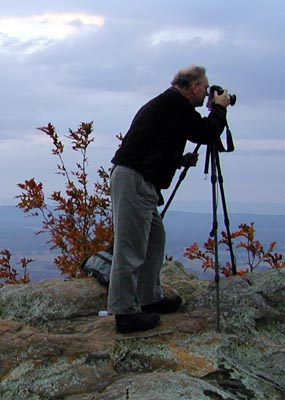
Shooting on Petit Jean Mountain
I took up photography as a hobby in 1999. It is an activity that fits well with my love of taking long hikes. I started out with a digital, Nikon CoolPix 900, which really started me taking lots of photos. A digital camera encourages that since it is so easy to throw away the bad ones and they don't cost you anything. In May, I purchased a coffee table book of beautiful landscape photographs done by Tim Earnst of Arkansas. I was really inspired and so began to wish I could get the same sort of shots with my camera. I soon realized I was limited by the small lens on the CoolPix, so I began to study photography books to determine what type of camera to purchase.
I figured I needed a medium format camera to get the fine grained images able to be enlarged like I wanted. However Tom at Memphis Photo Supply, suggested I talk to Tom Fox who was doing an exhibit of his work at the Ducks Unlimited Show. After talking to Tom Fox and seeing what he was able to do with a 35 millimeter format, I decided on the top of the line Nikon 35 millimeter SLR, the F5, which I purchased used in June. I have two lenses, the 28-105 f3.5 zoom and the 70-300 f4.0 zoom. I thought I would need some prime lenses eventually but these zooms have been very satisfactory so far. Besides, I do most of my photography while day hiking, and any more equipment to carry would be too burdensome. I really don't need a faster lens since most of what I shoot is on a tripod of landscape scenes, and I normally like to close the aperture down a bit or even a lot to get more depth of field. A wildlife photographer would need the faster lenses to get the action shots. The other equipment that I have are a Gitzo 1228 Mountaineer carbon fiber tripod, a Linhoff Profi II ball head, Really Right Stuff quick release plates, a Lowe Orion All Weather camera backpack (actually, more like a large fanny pack), a set of Galen Rowell graduated neutral density filters from Singh Ray, and a warming circular polarizer. The filters fit in a Cokin filter holder.
The major features of the F5 that I like are the depth of field preview, mirror lock up, a view finder with a large eye relief (good for glasses wearers), automatic bracketing, the ability to set the number of seconds for the self-timer, and the 3D color matrix metering mode.
To digitally process my best slides, I have a Nikon LS2000 film scanner, which will produce a 26.5 megabyte tiff file from a single slide, almost 9 million pixels! I use Adobe Photoshop to adjust the color levels to match the slide, and to spot away the dust on the slides. Sometimes I will crop the image to improve the composition but I am getting better at doing that with the camera in the field. I resize the images and convert them to jpeg format for normal viewing and for web publishing. I save the tiff files on a CDR disk for archive purposes. To produce a print, I use an Epson Photo Stylus EX, which will produce very large prints (11X17) with superb color renditions.
In December of 1999, I purchased a Nikon D1 and since then have gone completely digital using either my Coolpix or D1 exclusively. The D1 has most of the same features of the F5 and accepts all of the Nikon Lenses. The format is smaller than a 35 millimeter, about the size of an APS camera. The CCD produces about 2.7 million pixels.
The images in the galleries are my favorite photographs. You should be able to see the progression of my ability to take good photographs as you move through the months.
If you have the bandwidth, you can click on the picture to get a rather large image which requires a minimum of a 1024x768 monitor to appreciate. Enjoy.